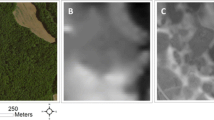Abstract
Wetlands that are not connected by streams to other surface-water bodies are considered to be isolated. Although the definition is based on surface-water connections to other water bodies, isolated wetlands commonly are integral parts of extensive ground-water flow systems, and isolated wetlands can spill over their surface divides into adjacent surface-water bodies during periods of abundant precipitation and high water levels. Thus, characteristics of ground-water flow and atmospheric-water flow affect the isolation of wetlands. In general, the degree that isolated wetlands are connected through the ground-water system to other surface-water bodies depends to a large extent on the rate that ground water moves and the rate that hydrologic stresses can be transmitted through the ground-water system. Water that seeps from an isolated wetland into a gravel aquifer can travel many kilometers through the ground-water system in one year. In contrast, water that seeps from an isolated wetland into a clayey or silty substrate may travel less than one meter in one year. For wetlands that can spill over their surface watersheds during periods of wet climate conditions, their isolation is related to the height to a spill elevation above normal wetland water level and the recurrence interval of various magnitudes of precipitation. The concepts presented in this paper indicate that the entire hydrologic system needs to be considered in establishing a definition of hydrologic isolation.
Similar content being viewed by others
Literature Cited
Cheng, X. 1994. Numerical analysis of groundwater and lake systems with application to the Trout River basin, Vilas Country, Wisconsin. Ph.D. Thesis. Department of Geology and Geophysics, University of Wisconsin-Madison, Madison, WI, USA.
Eisenlohr, W. S. Jr., and others. 1972. Hydrologic investigations of prairie potholes in North Dakota, 1959–1968. U.S. Geological Survery Professional Paper 585-A.
Fetter, C. W. 1988. Applied Hydrogeology. Merrill Publishing Co., Columbus, OH, USA.
Freeze, R. A. and J. A. Cherry. 1979. Groundwater. Prentice-Hall, Englewood Cliffs, NJ, USA.
Haitjema, H. M. 1995. Analytic Element Modeling of Groundwater Flow. Academic Press, San Diego, CA, USA.
Heath, R. C. 1987. Basic ground-water hydrology. U.S. Geological Survey Water-Supply Paper 2220.
Hess, K. M., J. A. Davis, D. B. Kent, and J. A. Coston. 2002. Multispecies reactive tracer test in an aquifer with spatially variable chemical conditions, Cape Cod, Massachusetts: dispersive transport of bromide and nickel. Water Resources Research 38: 36-1–36-27.
Krohelksi J. T., D. T. Feinstein, and B. N. Lenz 1999. Simulation of stage and hydrologic budget for Shell Lake, Washburn County, Wisconsin. U.S. Geological Survey Water-Resources Investigations Report 99-4209.
Krohelski, J. T., Y. Lin, W. J. Rose, and R. J. Hunt. 2002. Simulation of Fish, Mud, and Crystal Lakes and the shallow groundwater system, Dane County, Wisconsin. U.S. Geological Survey Water-Resources Investigations Report 02-20.
Leibowitz, S. G. and K. C. Vining. 2003. Temporal connectivity in a prairie pothole complex. Wetlands 23:13–25.
Schiebe, F. R., A. Swain, C. M. Cooper, and J. C. Ritchie. 1984. Materials budget of Lake Chicot. p. 1–17. In J. F. Nix and F. R. Schiebe (eds.) Limnological Studies of Lake Chicot, Arkansas. Ouachita Baptist University, Arkadelphia, AK, USA.
Siegel, D. I. and T. C. Winter. 1980. Hydrologic setting of Williams Lake, Hubbard County, Minnesota, U.S. Geological Survey Open-File Report 80-403.
Solid Waste Agency of Northern Cook County v. United States Army Corps of Engineers et al. 2001. Slip Opinions, 531 U.S., Part 1, Cases Adjudged in the Supreme Court at October Term 2000.
Stichling, W. and S. R. Blackwell. 1957. Drainage area as a hydrologic factor on the glaciated Canadian prairies. International Association of Scientific Hydrology Publication 45.
Tóth, J. 1962. A theoretical analysis of groundwater flow in small drainage basins. p. 75–96. In Proceedings of Hydrology Symposium No. 3, Groundwater. Queen’s Printer, Ottawa, ON, Canada.
Vecchia, A. V. 2002. Simulation of a proposed emergency outlet from Devils Lake, North Dakota. U.S. Geological Survey Water-Resources Investigations Report 02-4042.
Wiche, G. J., R. M. Lent, W. F. Rannie, and A. V. Vecchia. 1997. A history of lake-level fluctuations for Devils Lake, North Dakota, since the early 1800s. p. 34–39. In Proceedings of the 89th Annual Meeting, North Dakota Academy of Science, Grand Forks, ND, USA.
Wiche, G. J., A. V. Vecchia, L. Osborne, C. M. Wood, and J. T. Fay. 2000. Climatology, hydrology, and simulation of an emergency outlet, Devils Lake Basin, North Dakota. U.S. Geological Survey Water-Resources Investigations Report 00-4174.
Winter, T. C. 1976. Numerical simulation analysis of the interaction of lakes and ground water. U.S. Geological Survey Professional Paper 1001.
Winter, T. C. 1986. Effect of ground-water recharge on configuration of the water table beneath sand dunes and on seepage in lakes in the sandhills of Nebraska. Journal of Hydrology 86:221–237.
Winter, T. C. 1999. Relation of streams, lakes, and wetlands to groundwater flow systems. Hydrogeology Journal 7:28–45.
Winter, T. C. 2001. The concept of hydrologic landscapes. Journal of the American Water Resources Association 37:335–349.
Winter, T. C. and D. O. Rosenberry. 1998. Hydrology of prairie pothole wetlands during drought and deluge: a 17-year study of the Cottonwood Lake wetland complex in North Dakota in the perspective of longer term measured and proxy hydrological records. Climatic Change 40: 189–209.
Author information
Authors and Affiliations
Rights and permissions
About this article
Cite this article
Winter, T.C., LaBaugh, J.W. Hydrologic considerations in defining isolated wetlands. Wetlands 23, 532–540 (2003). https://doi.org/10.1672/0277-5212(2003)023[0532:HCIDIW]2.0.CO;2
Received:
Revised:
Accepted:
Issue Date:
DOI: https://doi.org/10.1672/0277-5212(2003)023[0532:HCIDIW]2.0.CO;2




